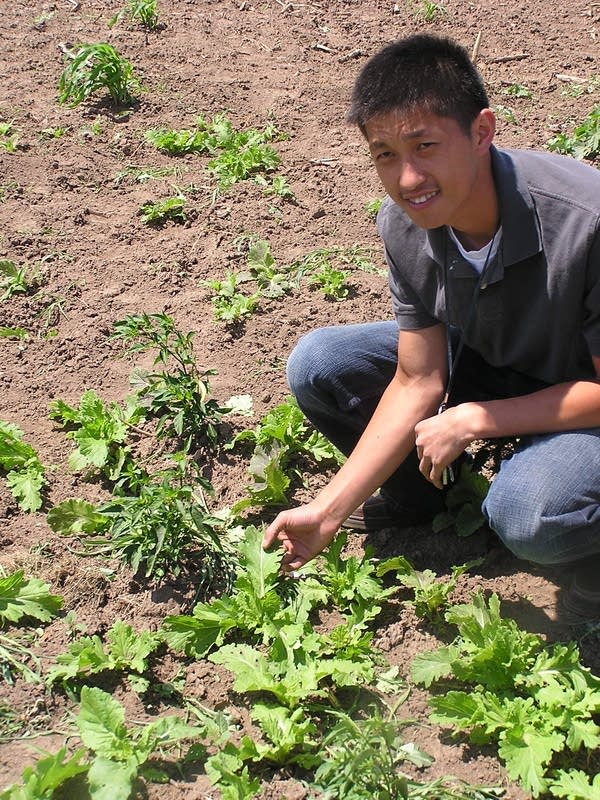Young farmer shares new vision for Hmong farming
Go Deeper.
Create an account or log in to save stories.
Like this?
Thanks for liking this story! We have added it to a list of your favorite stories.

This farming story starts at the Hennepin County Medical Center.
Mhonpaj Lee works as an interpreter. With long black hair and glasses, tidy in her business clothes, she jokes that she looks like a stereotypical East Asian straight-A student. But, then, you get her talking about what she just learned at a farming conference.

"How to fertilize with worms, how to make your own compost," Lee says, running off a list.
Like many Hmong children in Minnesota, Lee grew up helping her family work rented plots of land. She says because her parents were illiterate at the time, it was the only way to get food on the table.
Turn Up Your Support
MPR News helps you turn down the noise and build shared understanding. Turn up your support for this public resource and keep trusted journalism accessible to all.
"When I was younger, I promised myself that I would never farm because I hated it so much," Lee says. "I was like, 'I'm never going to return here. It's hot outside.'"
Now, looking back, she says, the experience shaped her identity.
"I feel like if I lose farming, that is lost to me. I am no longer Hmong," Lee says.
That's why after graduating from college, Lee decided to be a farmer. In addition to working at HCMC, she's in charge of the family farm plot.
Lee is learning more about farming at the Minnesota Food Association's New Immigrant Agriculture Project. At 22, she is the youngest participant.

Executive Director Glen Hill says the three-year program teaches cultivation, production and how to run a business.
"We're trying to train new farmers," says Hill. "The interest in becoming new farmers is primarily coming from immigrants and refugees."
On a windy day, Mhonpaj Lee's family is working her land. The Spanish radio blares as Hmong and Latino farmers tend to their crops.
While Lee is at the medical center, her mother May, her father and brother unravel black drip tape to irrigate the field. They call it, "Mhonpaj's Garden."
I feel like if I lose farming ... I am no longer Hmong.
They're using Western farming methods with row crops. It's very different from the traditional Hmong agriculture May learned in Laos.
For centuries, the Hmong mixed their crops in a way that seems haphazard to the Western eye, but worked well given the conditions in Laos. May used the same methods when she first arrived in Minnesota.
May says working the fields is a time for family. Here, she passes on her farming knowledge to her children. Parents and children also talk, plan dinner, and learn from one another as they water and weed. May also likes farming for another reason.
"Out here, you spend time -- whether eight hours, 10 hours, maybe four hours -- you do whatever you need to to tend to the fields. It's about independence, knowing that you control your own time," she says.
But independence isn't total -- most Hmong farmers work rented land. This year, with corn prices going through the roof because of the ethanol boom, some farmers found that the land they'd been using was now being used for corn.

The U.S. Department of Agriculture stepped in and successfully found other landowners with available plots to rent to the Hmong.
Back at Hennepin County Medical Center, Mhopaj Lee says there could be a similar problem next year.
She thinks the language barrier and confusion over government programs leads to Hmong farmers not knowing where to get help. Lee hopes to see even more tangible connections form between Hmong farmers and the people who can help them get better established.
Lee says if it weren't for the Minnesota Food Association, she still would be farming the way her family and many other Hmong families did while she was young -- harvesting plenty of produce, but not executing a strong business plan.
"Making lots of vegetables, tossing half of it away," Lee says. "Maybe if there's a farmer's market we can go and sell a little bit, make $20 off of it and throw the rest of it away."
It was only when she got involved with the Minnesota Food Association that she found out about food shelves, that she could donate her extra vegetables to churches and the homeless and get a valuable tax credit. The association plugged her into a network of resources, which was unlike anything her family had access to before.
Now, because of the association, Lee attends farming conferences. She hopes to spread the lessons she learns to other Hmong farmers.
Dear reader,
Political debates with family or friends can get heated. But what if there was a way to handle them better?
You can learn how to have civil political conversations with our new e-book!
Download our free e-book, Talking Sense: Have Hard Political Conversations, Better, and learn how to talk without the tension.





